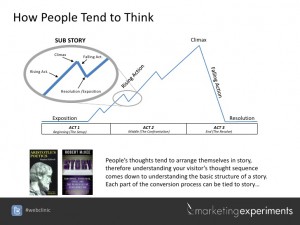Updated: June 18, 2013
On June 6th, I had the pleasure of watching a webinar produced by our friends at Marketing Experiments on writing landing pages (i.e. pages meant for direct conversions). The big theme of the hour-long presentation centered on writing under tight deadlines – something most of us who manage web sites and produce copy are well familiar with.
Of course, when you’re under the gun, you often end up working late just to produce something that may not be your best work.
But by following a step-by-step framework, writers can produce clear, concise copy that effectively communicates the value of whatever we’re offering.
Continue reading for part one of our synopsis of Marketing Experiment’s latest webinar – Copywriting on Tight Deadlines. Check back again later in the week as we explore how you can ensure you develop copy that follows the thought sequence of the vast majority of your site’s visitors
In writing landing page copy, clarity always trumps persuasion!
Those of us charged with drafting copy for landing/conversion pages, homepages, etc, often fret about creating the next masterpiece. Is our copy of Pulitzer quality?
One point Dr. Flint McGlaughlin emphasized – you don’t need to worry about writing great copy. What you do need to worry about is having a clear message and understanding of how human thoughts unfold.
Some of the advice put forth in McGlaughlin’s lesson may run contrary to what you’ve learned about copywriting. Rather than optimizing copy to include “power” words in their initial example, the team at Marketing Experiments optimized thought sequences instead.
(After their treatment of the page, conversions increased by an amazing 103%!)
Before we get into the how though, a few principles have to be clearly understood
To understand human thought sequence, we need to have a philosophic understanding of what “story” is all about. In the webinar, McGlaughlin referred us to a book written by Aristotle called “Poetics,” which kind of details how people tend to think. These principles are just as true in modern times as they were in Aristotle’s day.
The essential thing to understand is this – human thoughts tend to arrange themselves in story. Therefore, you have to be sure your copy coordinates with your visitor’s thought sequence, which requires a story-based framework.
In any story (…Star Wars is used as an example in McGlaughlin’s presentation), there are essentially 3 acts – the setup, the confrontation and the resolve. Within these 3 acts, we have an exposition, rising action, climax, falling action and resolution.

Let me quickly explain how these “acts” relate to landing pages:
Exposition – In relation to landing pages and conversions, the exposition or main story usually occurs in the channel, be it the search engine results or PPC ad. Its purpose is to engage the visitor and build the problem, which will eventually lead to a resolution. The exposition poses a “connecting question” and then works to intensify that question.
Rising Action – The overarching goal of the rising action is to continue to intensify the problem and present your value as the unique solution to that problem.
Climax – The climax occurs at the point of decision for the main conversion, whether it’s clicking buy, submitting further info (lead generation) or completing information to download an e-book. It occurs at your call-to-action most of the time and is where the rising action is at its highest intensity. The climax doesn’t involve the actual purchase but the decision to purchase.
Falling Action – This occurs after the visitor’s decision to take your offer and involves steps needed to finalize the conversion. It generally consists of steps needed to “actualize” their decision, which means entering payment info, shipping info or other information needed to deliver your offer.
Resolution – The resolution occurs when the visitor has completed the transaction and is satisfied with their decision. In philosophic terms, this is referred to as the actualization of the value exchange. The resolution is supposed to bring peace and reassure the visitor of their decision.
In essence, by knowing where each of these elements falls into your “story,” you can construct each word, sentence and paragraph to purposely match your visitor’s thought sequence.
Again, you don’t have to write Pulitzer level work. What’s most important is your words are clear and communicate the value of your offer effectively.
From these principles, we can next dive into a step-by-step framework you can use to develop copy that closely resembles the thought sequence of your readers.
We invite you go ahead and watch the webinar below…and check back with us later in the week for part II of our comprehensive summary on Copywriting on Tight Deadlines!
